Staying Healthy and Mobile In Retirement
I’m passionate about helping people use their money to live a better life. I’ve written hundreds of blog posts and recently finished a book manuscript to these ends. But I have no formal training in investing or financial planning.
I’m also passionate about helping people improve their health and fitness to live a better life. I’ve spent a couple decades developing expertise as a physical therapist and certified athletic trainer. Yet I’ve never written about exercise, injury prevention, and overall physical health.
I recently participated in a panel discussion on the What’s Up Next? Podcast discussing the connection between financial independence and physical health and fitness. That conversation clarifies how physical and fiscal health are each vital to living life to the fullest. It also inspired me to start sharing my knowledge and experience related to living healthier lives and remaining active as we age.
Part of my desire to retire as a physical therapist was boredom. There was tremendous repetition in the presentation of common faulty postures and movement patterns. They required similar interventions to alleviate my client’s symptoms and prevent recurrence. The same movement patterns and same solutions were seen over and over. . . and over again.
Treating these impairments became monotonous for me when performed repeatedly in a one on one setting. However, they provide the perfect place to start writing about this topic.
Exercising correctly can keep you mobile and healthy. This in turn allows you to enjoy the retirement you’re working, or have worked, so hard to achieve.
I’ll start today with common mobility issues that predispose you for injury. Next month, I’ll follow up with ideas on maintaining and improving strength as we age.
Can/Should You DIY?
Before diving into common mobility issues and how to address them, let’s start with a foundational question. Can and should you try to exercise on your own or should you seek professional help and guidance?
Similar to financial issues, there is no universal right or wrong answer. I recommend that you be honest with yourself. Don’t be penny wise and pound foolish with things as important as your health and fitness (or your money).
Even if you have the requisite interest, knowledge, and motivation to improve your mobility and fitness, some problems are inherently harder for you to manage on your own. Examples are stiffness of the shoulders, thoracic spine (upper back), hips and certain movements at the ankle.
As with personal finance, there are many “experts” in the area of health, fitness, and exercise who disperse bad information. A large part of my physical therapy practice was picking up their broken pieces.
I will provide you with simple exercises to prevent common movement impairments before they become symptomatic. If you are unable to perform any movement without pain, stop and seek qualified help from a fitness or health professional.
If you have any pre-existing injuries or medical conditions, it is vital that you seek help from a qualified professional. I recommend seeking out a physical therapist over other fitness professionals who generally have little or no training regarding injuries or disease processes.
Upper Body Posture
We tend to sit too much from classrooms to desk jobs to home PCs, commuting in cars, and working/playing on electronics devices. This leads to a most people having poor sitting posture.
This poor posture manifests with the same impairments:
- Reversal of normal lumbar curve (slouched lower back)
- Excessive thoracic kyphosis (rounded/hunched upper back)
- Excessive cervical extension (looking up)
- Protracted/downward rotated scapula (rounded shoulders)
- Internally rotated shoulders (palms back)
- Loss of shoulder extension (inability to reach arms back away from back)
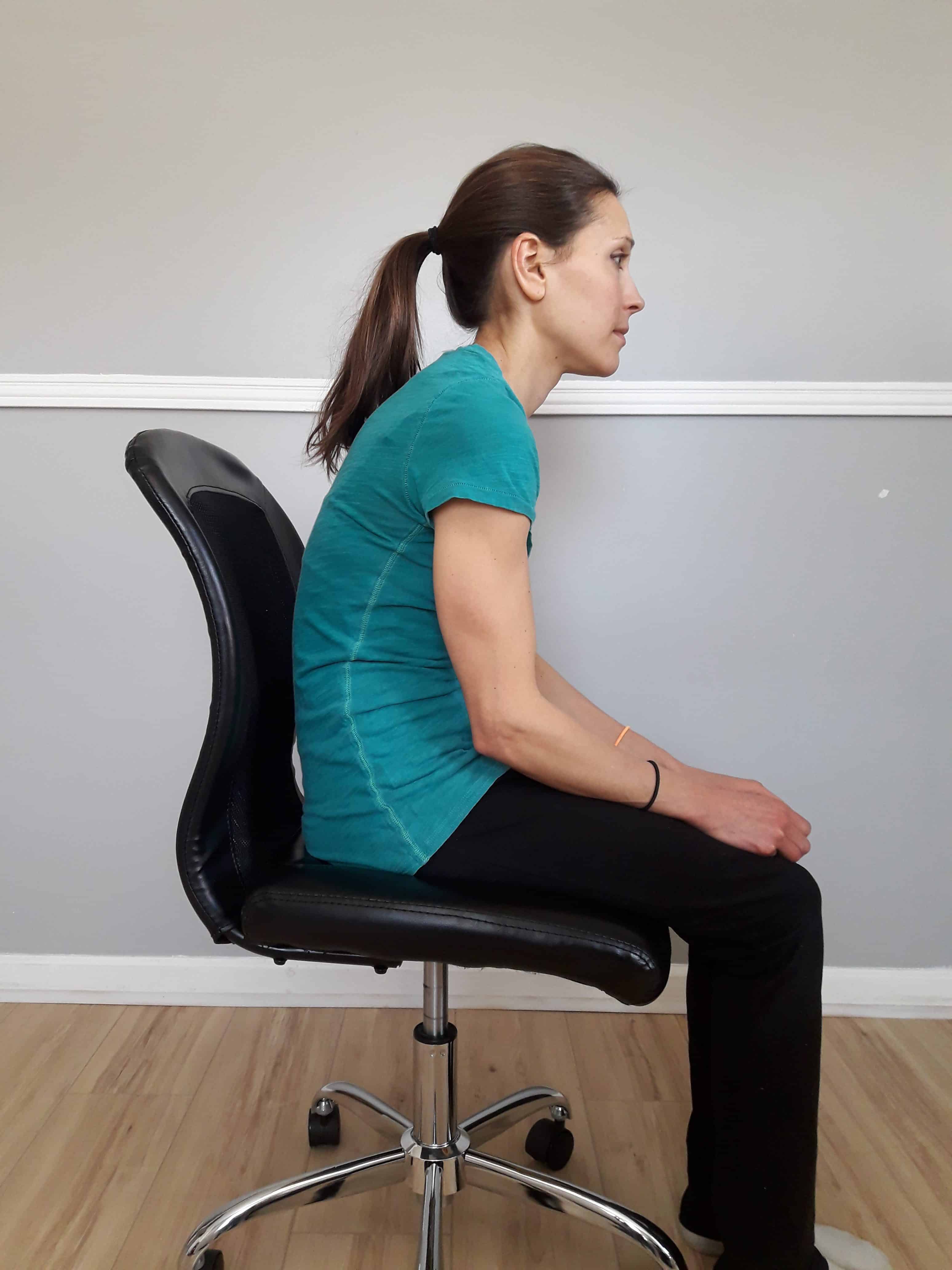
These postural impairments rarely will occur in isolation. Instead, they build upon one another.
For example, try to sit with a slouchy posture and pinch your shoulder blades together. It feels very abnormal if not impossible.
Now sit up tall and do the same movement. Assuming you have not lost the muscle control to pinch your shoulder blades together, it will feel natural.
Cervical (neck) extension is a compensation for a rounded lower and middle back. If you didn’t compensate, you’d spend the whole day looking at your feet. Thus we extend at our neck to keep our eyes looking straight ahead.
Trying to stretch tight upper neck muscles without addressing posture lower in the chain is futile. Conversely, you may be able to correct downstream compensations without directly intervening if you can address root causes.
These postural impairments are associated with the most common complaints I saw as a physical therapist. This includes low back pain, lumbar disc herniations, mid-back pain, neck pain, cervical radiculopathy, tension headaches, shoulder impingement, rotator cuff injuries and thoracic outlet syndrome. Even though patients present with a wide variety of symptoms and diagnoses, interventions tend to look remarkably similar.
Simple First Steps
Most people can’t get away from sitting. Gravity is constantly at work. Therefore, you don’t “correct” this posture as much as you manage it. This requires consistency with positioning and exercise.
For people who spend a large portion of their day sitting, the first and easiest solution is to start by improving low back support. Everything else will automatically improve.
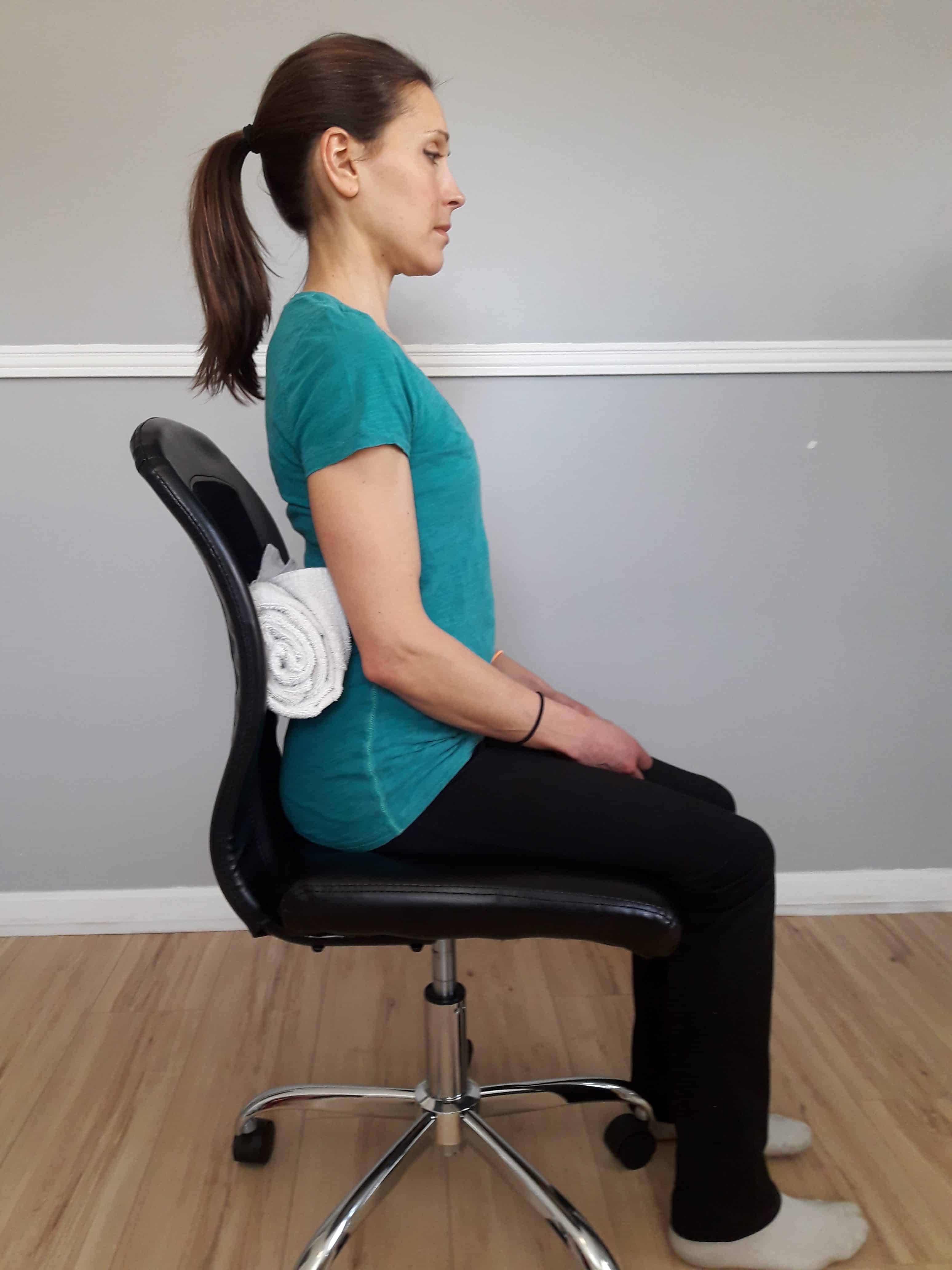
There are many lumbar support products out there. But we want to save more, invest (in our health) better, and retire sooner. Conveniently, a frugal solution is also the optimal solution here.
A great fix is to roll up a towel and place it in the small of the back, just above your sacrum (tailbone). This will force you to maintain a more neutral low back while sitting. This causes everything above to passively improve as well.
Your towel is also customizable. You can experiment with larger or smaller supports until you find your position of comfort.
Another helpful tip is to customize the place(s) that you sit most to promote ideal posture. For example, get into a good posture and then adjust the rear view mirror in your car. What you see (or don’t see) in your mirror will provide feedback to your posture.
Composite Upper Body Motions
Because these impairments tend to occur together, they can be addressed with a few simple exercises that can easily be incorporated into your daily routine. The key with any exercise program is to establish goals and realistic expectations.
Because we spend so much time sitting with poor posture we face a constant fight against gravity. So these exercises need to become a part of your daily routine for them to be effective. Rather than thinking you will change your posture radically, think of the exercises as “postural breaks.” The goal is to alleviate the constant strain on your soft tissues. None of these movements should cause any pain, though you should experience a mild stretching sensation.
Over time this may lead to lasting structural changes as well. But that process is slow.
Bilateral Shoulder External Rotation With Breathing
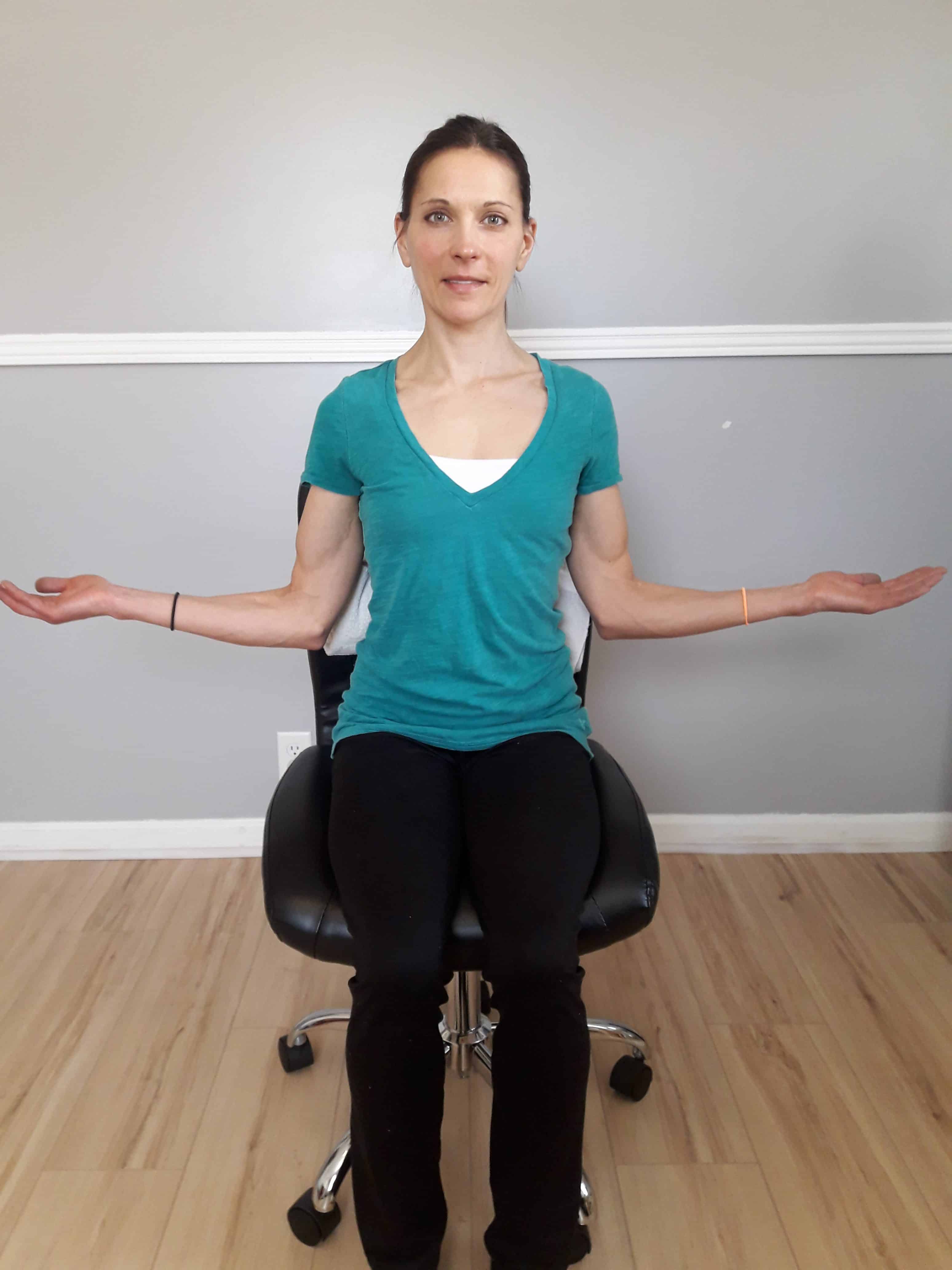
The first two exercises require no equipment, very little time and can be performed anywhere. Thus, they can and should be performed frequently. It is helpful to use some type of cueing to make this habit. Examples are setting an alarm on your phone to go off every 1-2 hours, performing the exercises in the car at every red light, etc.
The first exercise helps reverse faulty posture with one gentle and fluid movement. Start by slightly tightening the abdominals and sitting erect. Bend the elbows and keep them tight at your side.
Take a deep breath in while gently rotating the shoulders so the hands move away from the body. Do not force the movement, because this tends to make you shrug the shoulder blades and tilt them forward which is the opposite of what we are trying to accomplish.
Instead, focus on allowing the movement of your arms help pinch the shoulder blades down and back while you extend your upper back. On your exhalation, reverse the movements so you can feel the difference between the “good” and “bad” postures and learn to move between them. Repeat 10 breaths/movements.
Scapular Retraction/Depression
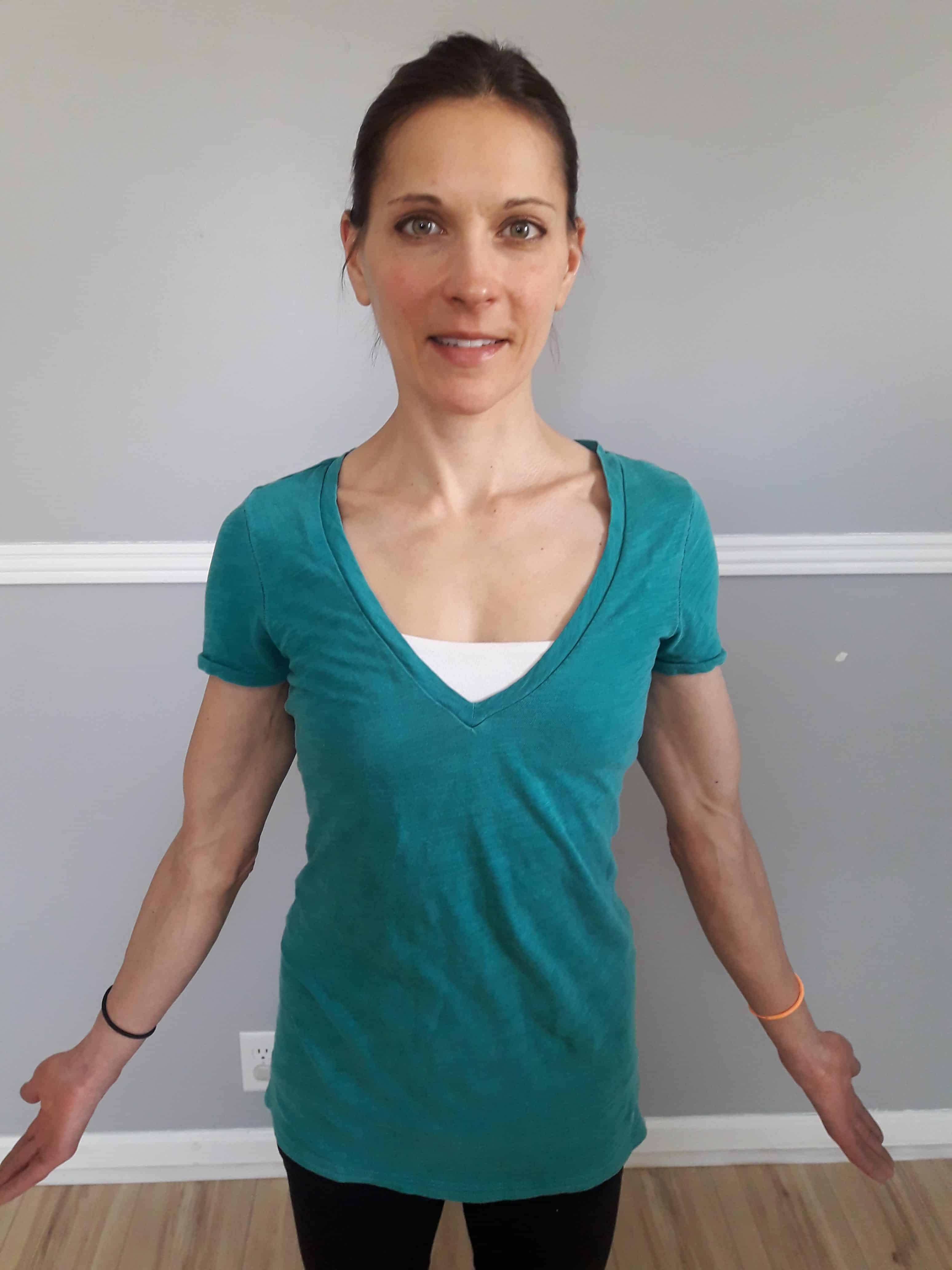
Sit upright or stand with your arms at your side. Rotate your arms so the palms face forward.
Pinch the shoulder blades together and then reach for the floor by depressing the shoulder blades. Hold 5-10 seconds. Start with 10 repetitions.
This exercise has two purposes. First, it provides a gentle stretch on the chest and neck muscles which get tight with a typical sitting posture.
Second, it activates the scapular stabilizing muscles that tend to become stretched, inhibited and weak.
Thus it is a prerequisite to performing more advanced upper body strengthening exercises.
Foam Roller Positioning
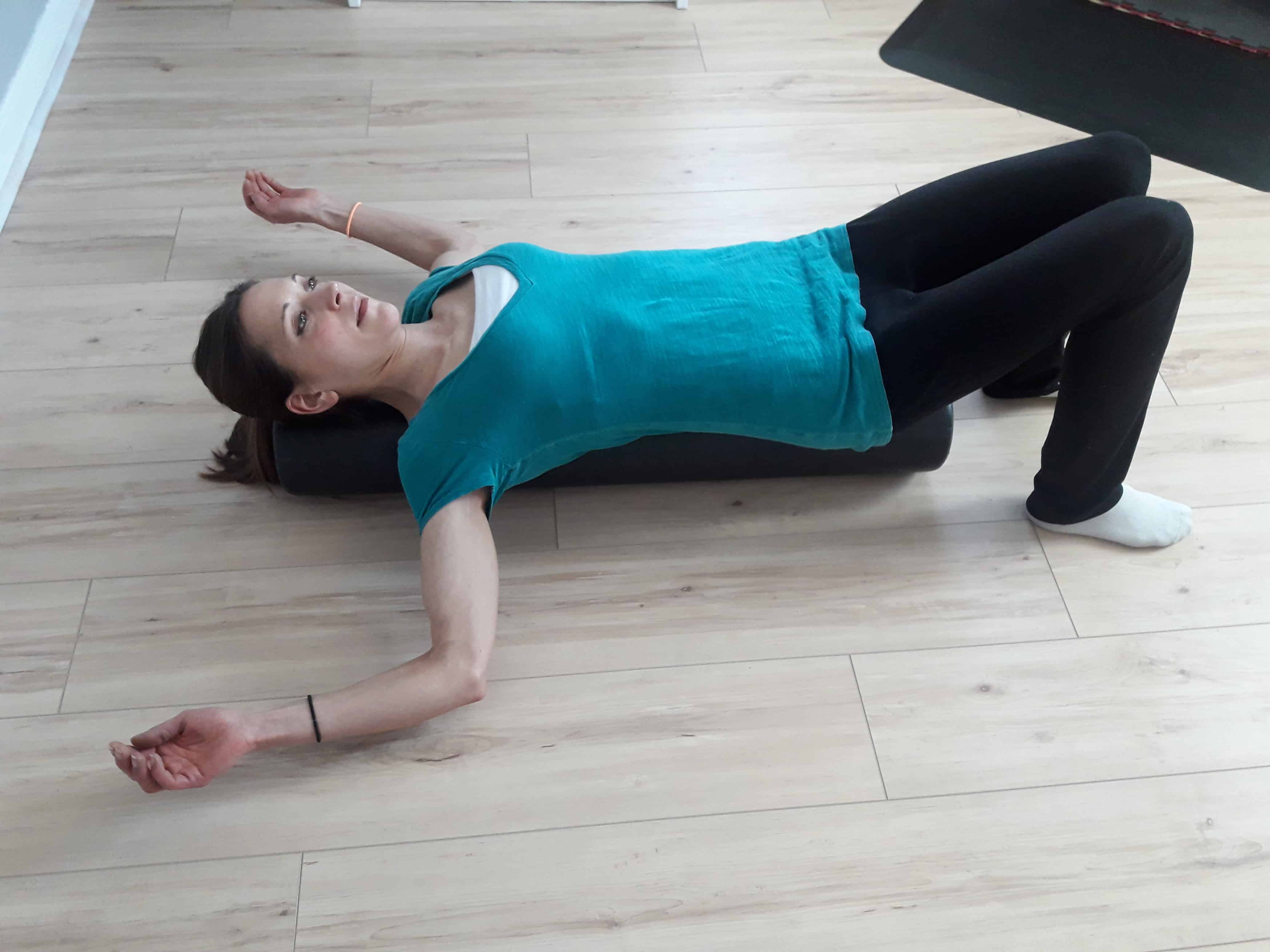
The next exercise requires a high density foam roller. This is an inexpensive and versatile tool that is a valuable addition to any home gym. The roller should be long enough to support from the top of your head to your tailbone.
Simply lie on your back with the foam roller supporting your spine. Flex your hips and knees so your feet are flat on the floor, allowing you to feel stable and relaxed.
Assuming you don’t have fixed deformities of the spine, the lower and upper back will naturally assume improved positions. You can gently tuck your chin towards your chest to alleviate strain on the muscles of the upper neck.
Allow your arms to fall out to the side with the elbows bent. This provides a gentle stretch on your pectoral (chest) muscles and puts the shoulders into a position of external rotation.
If this position is uncomfortable on the shoulders or you have a history of shoulder pathology, you can instead try a less stressful position of lying with your arms at your side to start.
Do at least one minute in this position. You can maintain the position for as long as it is comfortable and do it as often as possible.
Lower Body Mobility
There are common repetitive patterns of mobility loss in the lower extremities as well. Several of these are related to too much sitting.
As with the upper body, these common impairments are associated with a variety of symptoms and diagnoses including low back pain, hip and knee arthritis/pain, patellofemoral pain (pain in the front of the knee), achilles tendonitis and plantar fasciitis.
In the lower extremity, mobility issues nearly always involve tightness of the muscle groups that cross two different joints. They include the hip flexors (cross the lumbar spine and hip joints), the quadriceps and hamstrings (cross the hip and knee joints) and calf muscles (cross the knee and ankle joints).
This loss of muscle flexibility can be accompanied by loss of mobility at the hip, knee or ankle joints. Restoring lost joint mobility may require skilled therapy or even surgical interventions in some circumstances.
The flexibility exercises are a good starting point, assuming you are gentle and the exercises are able to be performed pain-free. If you experience pain with these movements or are not noting any improvement in mobility over time, seek qualified medical help.
There is not an optimal duration or frequency for performing the exercises. More often and longer duration are generally better. A good starting point is holding each stretch for 30 seconds and repeating three times. Do the stretches daily.
Hip Flexor Stretching
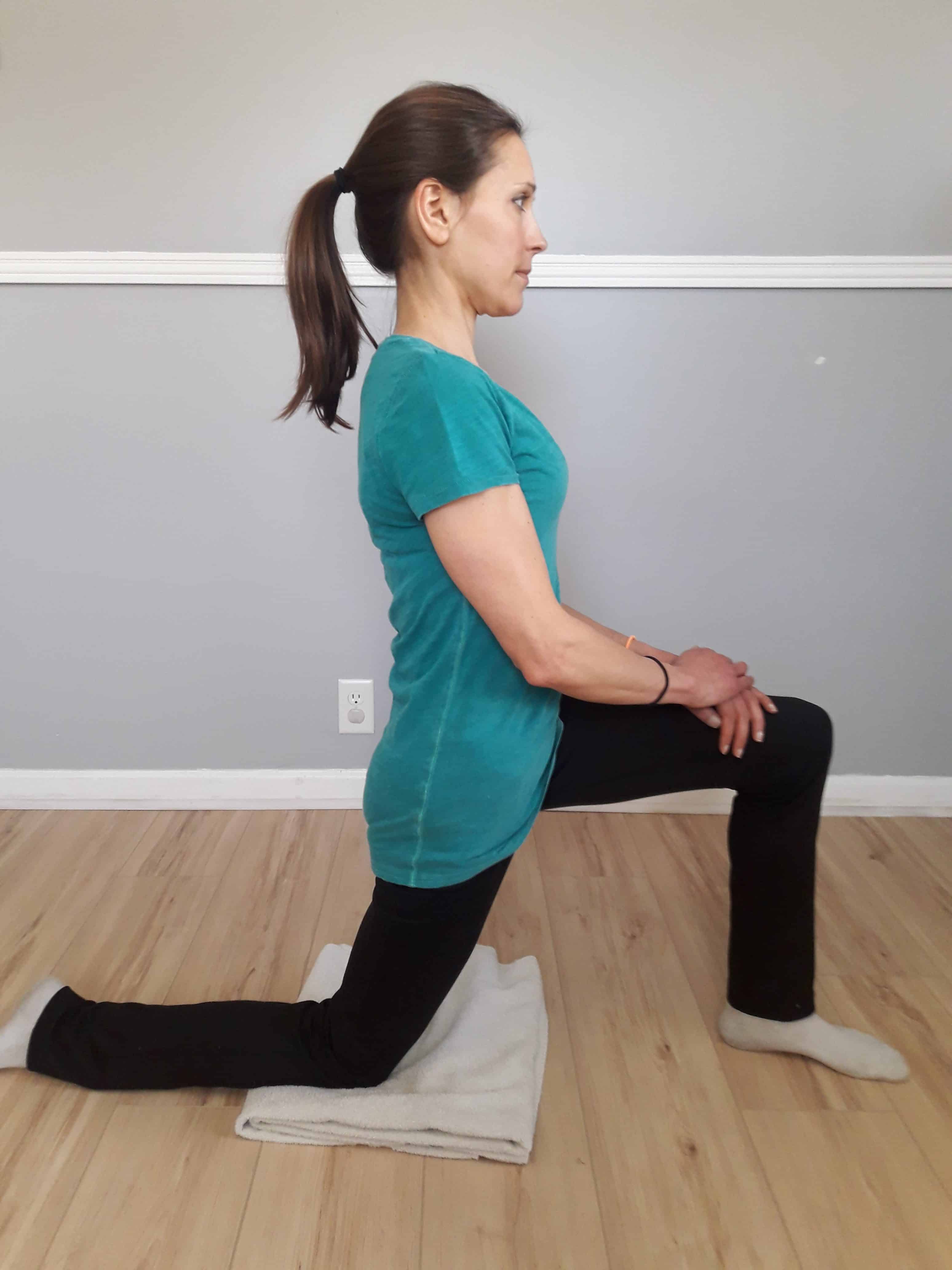
Hip flexion is the position of the hips when sitting. Thus the muscles that flex the hips are frequently in a shortened position, contributing to their tightness.
The psoas major is one of the hip flexor muscles that originates on the lumbar spine and crosses the front of the hip joint. Stretching it properly requires extending the hip (the opposite of flexion) while also maintaining a stable lumbar spine.
The easiest way to stretch the hip flexors is to place the knee of the leg to be stretched on the ground (use padding under the knee). The opposite foot is placed flat on the floor. Then shift your weight forward until a comfortable pulling is felt in the front of the hip/upper thigh.
Maintain the position of your trunk. Avoid leaning forward which flexes the hip and prevents proper stretching. Avoid arching the back which places unnecessary strain on it.
Hamstrings Stretching
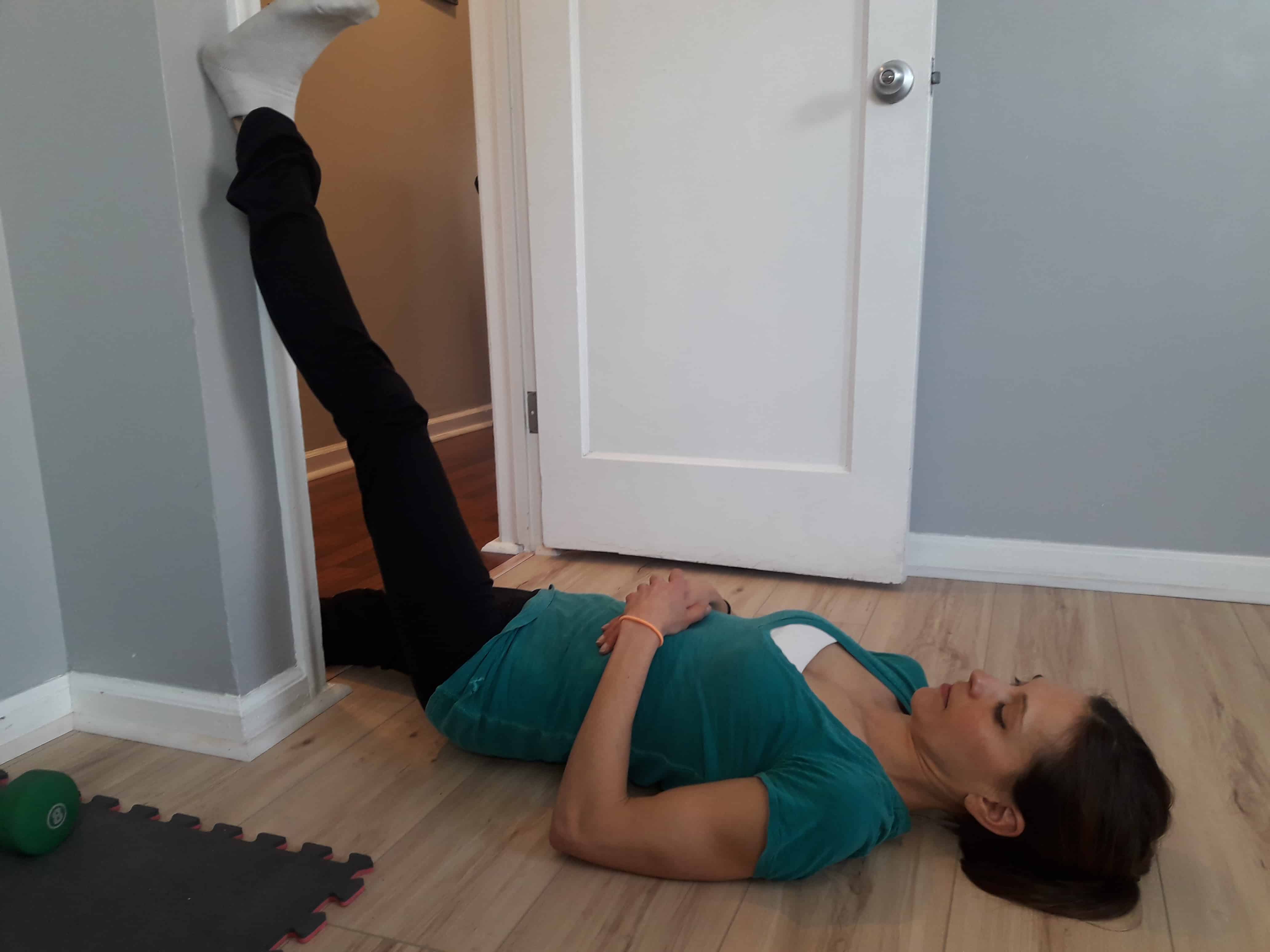
The hamstrings consist of three muscles that sit on the back of the thigh. All three originate on the pelvis and attach on the lower leg. Their function is to flex (bend) the knee and extend (opposite of flexion) the hip.
Stretching the hamstrings requires straightening the knee and flexing the hip without slouching at the lower back (slouching tilts the pelvis and shortens the hamstrings). This subtle distinction of stabilizing the pelvis means that most people don’t stretch their hamstrings, even when they try.
The easiest way to position yourself properly to stretch the hamstrings is to lie on your back in a doorway. Place one leg flat on the floor. Place the heel of the leg you are stretching on the door jam while keeping the knee straight. Gradually scoot in toward the doorway until a comfortable pull is felt in the back of the leg. Stop if you start to feel the pelvis rotate or lift from the floor.
Quadriceps Stretching
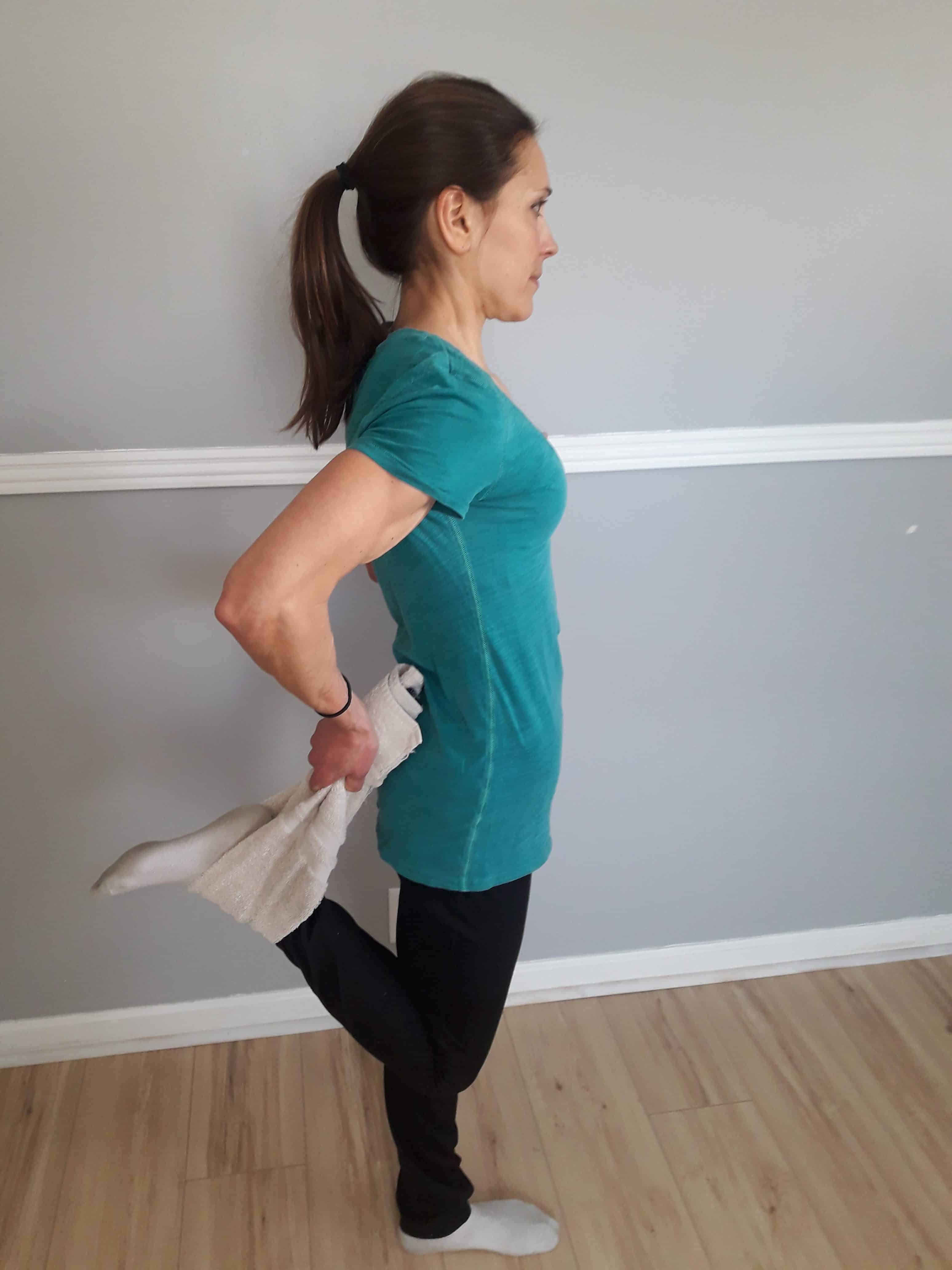
The quadriceps are the four large, powerful muscles that sit on the front of the thigh. Their primary action is to extend (straighten) the knee. Three of the four quads originate on the femur (thigh bone), don’t cross the hip joint and, unless immobilized, rarely get tight so they don’t need to be stretched.
So stretching the quadriceps really means stretching the rectus femoris. This is the fourth quadriceps muscle and the only one that crosses the hip joint. This is an important distinction, because it dictates how you stretch the muscle.
To perform this stretch, stand on the opposite leg. Place one hand on a wall or counter top for balance. Bend the knee of the leg you want to stretch as far as possible by grabbing the ankle. You can use a towel around the ankle to assist you.
To stretch the rectus femoris, you also need to extend the hip. You accomplish this by driving the pelvis forward while pulling the knee back under the body.
Calf Stretching
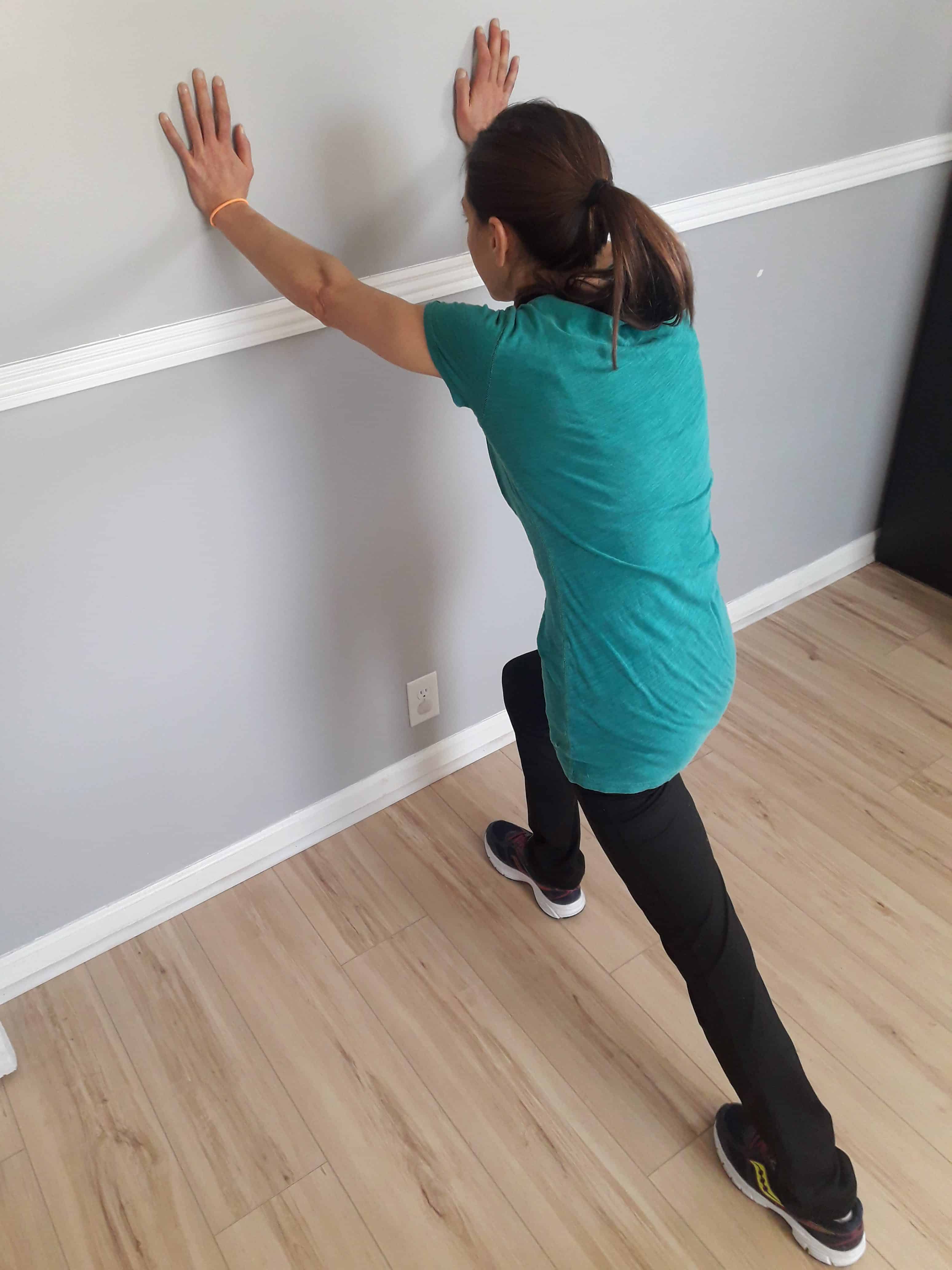
The “calf muscle” is actually a group of muscles. The gastrocnemius is one of the group which crosses both the back of the knee and ankle joints and is what most often becomes tight.
As a group, the primary action of the calf muscles is to plantarflex the ankle (lift you from flat foot to standing on toes). Tightness of the calf prevents dorsiflexion of the ankle (bringing the top of the foot toward the shin).
Loss of dorsiflexion range of motion of the ankle leads to compensations that contribute to many lower extremity problems. Adequate dorsiflexion is required for proper squatting, descending stairs and walking up hills or ramps.
To stretch the gastrocnemius, stand with the hands against a wall with the feet staggered. The foot you are stretching should be back, flat on the floor, with the toes pointed directly to the wall. To isolate the gastrocnemius, keep the knee straight. Shift your weight forward until a stretch is felt in the calf.
Muscle tightness is only one cause of decreased ankle dorsiflexion. If you are limited by discomfort or tightness in the front of the ankle before feeling any stretch in the calf musculature, don’t force the motion.
Get Moving
Having adequate mobility is the foundation upon which all other fitness can then be built. Higher level strength, balance and functional exercises are pointless at best and dangerous at worst in the absence of basic mobility.
The exercises shared in this post are very basic by design. They provide the foundation for normal pain free mobility which enables daily function and higher level activities.
I’ve prescribed some variation of the exercises outlined to nearly every patient that walked into my physical therapy clinic over the past fifteen years. I also incorporate these foundational movements into my daily routine. Gradually start incorporating them into your routine to keep yourself moving and healthy.
* * *
Valuable Resources
- The Best Retirement Calculators can help you perform detailed retirement simulations including modeling withdrawal strategies, federal and state income taxes, healthcare expenses, and more. Can I Retire Yet? partners with two of the best.
- New Retirement: Web Based High Fidelity Modeling Tool
- Pralana Gold: Microsoft Excel Based High Fidelity Modeling Tool
- Free Travel or Cash Back with credit card rewards and sign up bonuses.
- Monitor Your Investment Portfolio
- Sign up for a free Empower account to gain access to track your asset allocation, investment performance, individual account balances, net worth, cash flow, and investment expenses.
- Our Books
- Choose FI: Your Blueprint to Financial Independence
- Can I Retire Yet: How To Make the Biggest Financial Decision of the Rest of Your Life
- Retiring Sooner: How to Accelerate Your Financial Independence
* * *
Disclosure: Can I Retire Yet? has partnered with CardRatings for our coverage of credit card products. Can I Retire Yet? and CardRatings may receive a commission from card issuers. Some or all of the card offers that appear on the website are from advertisers. Compensation may impact on how and where card products appear on the site. The site does not include all card companies or all available card offers. Other links on this site, like the Amazon, NewRetirement, Pralana, and Personal Capital links are also affiliate links. As an affiliate we earn from qualifying purchases. If you click on one of these links and buy from the affiliated company, then we receive some compensation. The income helps to keep this blog going. Affiliate links do not increase your cost, and we only use them for products or services that we're familiar with and that we feel may deliver value to you. By contrast, we have limited control over most of the display ads on this site. Though we do attempt to block objectionable content. Buyer beware.